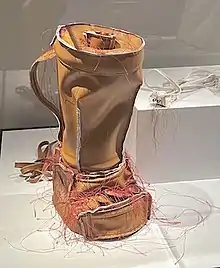Margarita Cabrera
Margarita Cabrera (born 1973) is a Mexican-American artist and activist. As an artist, the objects and activities she produces address issues related to border relations, labor practices and immigration. Her practice spans smaller textile-based soft sculptures to large community-involved public artworks. In 2012 she was a recipient of the Knight Artist in Residence at the McColl Center for Visual Art in Charlotte, NC. Cabrera was also a recipient of the Joan Mitchell Foundation Grant.
Margarita Cabrera | |
|---|---|
| Born | 1973 (age 49–50)[1] Monterrey, Mexico |
| Known for | soft sculptures, border art |
Early life and education
Cabrera was born in the city of Monterrey in the state of Nuevo Leon, México.[1] She moved to the U.S. at around the age of 10, when her family was in search of better opportunities. Her inspiration to become an artist began in her childhood, when she was exposed to the Montessori system of education.[2][3]
Cabrera received a BFA degree in 1997 and an MFA degree in 2001 from Hunter College in New York, New York.[4][5]
Work

Cabrera's artistic output includes both contemporary sculpture and public artworks.
Cabrera's soft sculptures are modelled on the shape of common appliances and machines, created from fabric and thread.[6] She has made soft sculptures of coffee makers,[7] bicycles,[8] sewing machines,[9] backpacks,[8] as well as the Hummer[10] and Volkswagen beetle[11][12] automobiles. Cabrera has stated that these works are intended as an insight into the lives of laborers working in the Mexican appliance factories, or maquiladoras, that produce the real articles just south of the US-Mexico border.[13][14][15] In the process of creating her soft sculptures, Cabrera often works with displaced immigrants living on the American side of the border.[16][17]
Cabrera's use of community involvement in the production of her soft sculptures has led her to create more engaged public artworks. Since 2010 she has run workshops on the production of art projects in Arizona and Texas, inviting the participation of new immigrants.[18][19]
Cabrera is an assistant professor in the Herberger Institute for Design and the Arts at Arizona State University.[20]
Public Art
Collections
- Allen Memorial Art Museum[26]
- Smithsonian Museum of American Art[1]
- Museum of Fine Arts Houston[27]
- McNay Museum, San Antonio
- Sweeney Center for Contemporary Art at the University of California, Riverside
- Sun Valley Center for the Arts
- El Museo del Barrio, New York City[28]
References
- "Margarita Cabrera | Smithsonian American Art Museum". americanart.si.edu.
- Agresta, Michael (22 March 2019). "Margarita Cabrera's Monumental 'Arbol de la Vida' Grows in San Antonio". Texas Monthly.
- Garcia, Yazmin M. "Artist Margarita Cabrera works through challenges to engage communities on social, political issues". Borderzine.
- Held, Peter; Lineberry, Heather Sealy (22 November 2013). Crafting a Continuum: Rethinking Contemporary Craft. UNC Press Books. ISBN 978-1-4696-1281-2.
- Bonansinga, Kate (6 January 2014). Curating at the Edge: Artists Respond to the U.S./Mexico Border. University of Texas Press. ISBN 978-0-292-75443-0.
- Museum, Smithsonian American Art; Ramos, E. Carmen (2014). Our America: The Latino Presence in American Art. Smithsonian American Art Museum. ISBN 978-1-907804-44-1.
- Zanetell, Myrna. "Margarita Cabrera". El Paso Inc.
- Writer, Betty Ligon El Paso Inc. "It's Margarita's turn for applause – for her sagging Hummer". El Paso Inc.
- Szymanek, Angelique (15 October 2020). "Haptic Encounters: Margarita Cabrera's Space in Between". Art Journal Open.
- Ryzin, Jeanne Claire van. "Van Ryzin: The threads of art, politics in intriguing exhibit at the MACC". Austin American-Statesman.
- Johnson, Ken (9 April 2010). "They're Chicanos and Artists. But Is Their Art Chicano? (Published 2010)". The New York Times.
- "Bicultural and Multilevel: Margarita Cabrera". Glasstire. 2 January 2005.
- Hung, Shu; Magliaro, Joseph (2007). By Hand: The Use of Craft in Contemporary Art. Princeton Architectural Press. ISBN 978-1-56898-610-4.
- Bunch, Robert Craig (23 September 2016). The Art of Found Objects: Interviews with Texas Artists. Texas A&M University Press. ISBN 978-1-62349-407-0.
- Blanco-Cano, R.; Urquijo-Ruiz, R. (30 November 2011). Global Mexican Cultural Productions. Springer. ISBN 978-0-230-37039-5.
- Trimble, Lynn (22 June 2018). "How 10 Artists Tackle Immigration". Phoenix New Times.
- "THE WELLIN MUSEUM OF ART PRESENTS MARGARITA CABRERA: SPACE IN BETWEEN" (PDF). hamilton.edu/.
- Durón, Maximilíano (8 June 2018). "Searching for the In-Between: Margarita Cabrera's Collaborative Art Thinks Beyond Borders". ARTnews.com.
- "Arbol De La Vida - Sculptures Take Form". Texas Public Radio. 30 June 2017.
- "Margarita Cabrera". herbergerinstitute.asu.edu. 22 December 2020.
- Boucher, Brian (28 April 2015). "Artist Threatens Suit over Public Sculpture". artnet News.
- "City-Commissioned Sculpture Raises Questions Of Censorship". KJZZ. 22 June 2015.
- "Árbol de la Vida: Memorias y Voces de la Tierra – San Antonio River Foundation". sariverfound.org/.
- Martinez, Norma (27 March 2019). "San Antonio Stories Blossom With Árbol De La Vida". Texas Public Radio.
- Martin, Deborah (17 May 2019). "River Foundation unveils massive new public artwork near Mission Espada". San Antonio Express–News.
- "Bicicleta azul platino (Platinum Blue Bicycle)". allenartcollection.oberlin.edu.
- "Margarita Cabrera Bicicleta: Amarilla". emuseum.mfah.org/.
- "QUEENIE: Selected artworks by female artists from El Museo del Barrio's Collection | El Museo del Barrio". elmuseo.org.